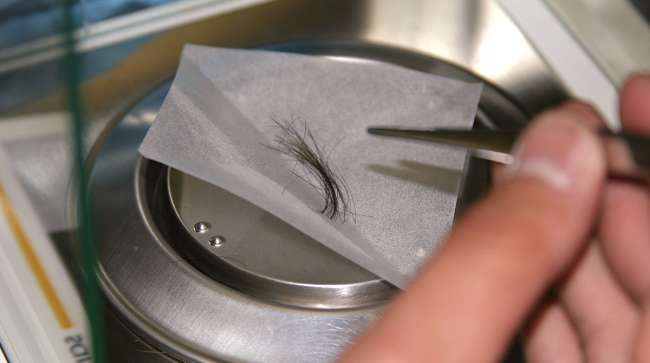Senior Reporter
Federal Drug Official Defends Proposed Guidelines for Hair Testing

[Stay on top of transportation news: Get TTNews in your inbox.]
The chairman of a federal drug-testing advisory board that developed the controversial proposed mandatory guidelines for hair drug testing of truck drivers, other workers in safety-sensitive jobs and federal employees has responded to what he called “misconceptions” about the proposal by opponents.
“As the director of workplace programs at the Substance Abuse and Mental Health Services Administration and the chairman of SAMHSA’s Drug Testing Advisory Board, I am concerned about misconceptions regarding the recent proposed hair-testing guidelines and would like to shed some light on the subject,” SAMHSA’S Ron Flegel wrote in a Sept. 18 letter obtained by Transport Topics.
The proposed guidelines, detailed in a Sept. 10 Federal Register announcement, drew immediate opposition from some trucking trade groups, including American Trucking Associations, which characterized the proposal as “weak” and “misguided.”
SAMHSA Lettter Regarding Ha... by Transport Topics
A provision in the guidance requires employers to also perform a urine or oral swab drug test when a prospective employee tests positive for drug use in a hair sample test. The hope among many motor carriers and other stakeholders has been that the hair tests alone would suffice as an alternative to urine and oral swab testing, despite the outcome of a hair test.
Flegel’s letter, addressed to “whom it may concern,” was provided to Transport Topics after a reporter requested comment on the proposal. At press time, apparently it had not been sent to trucking industry stakeholders.
SAMHSA is a subagency of the U.S. Department of Health and Human Services, which ultimately is responsible for approving the drug testing guidance using hair samples.
“Contrary to the views of some stakeholders, the feature of authorizing another specimen to be collected does not diminish the value of hair testing,” Flegel wrote. “Roughly 90% of all hair tests return negative results, which means federal agencies and federally regulated entities will have the flexibility to eliminate urine or oral fluid testing in approximately 90% of cases where a donor provides a hair specimen for testing.”
HHS Hair Rule by Transport Topics
The letter also said, “This would leave the benefits of hair testing intact for approximately 90% of hair tests. It should also be noted that if the donor provides a legitimate medical explanation for the positive hair test result, the medical review officer reports the test as negative to the employer. If the donor admits illicit drug use, the MRO reports the test as positive to the employer. In these cases, the proposal does not require that an alternative specimen be tested.”
In a Sept. 21 statement, ATA said, “The short letter by SAMHSA is more of the same and shows how unseriously they took the task that Congress gave them — to produce guidelines to make hair testing an acceptable alternative to urinalysis for commercial drivers.
“In the real world, hair testing isn’t about the negative tests cited by SAMHSA, it’s about the more than tenfold increase in ability of hair tests to identify banned drug use. Alternate samples tested with urinalysis or oral fluids miss drug use detected by hair tests — which is why a growing number of companies use it, and it’s why regulators in Europe and South America have been relying on hair testing for years.”
ATA added, “Data will prevail in this debate, and SAMHSA’s misguided rule will be fixed.”
In his letter, Flegel said the department’s hair testing proposal “facilitates” progress in addressing certain gaps in the current state of hair-testing scientific and legal issues, including the risk of environmental contamination and the impact of hair color.

Home | Video | Heroes' Photo Gallery
Saluting the men and women of the trucking industry who kept America's essential goods flowing during the coronavirus pandemic.
Heroes: Peter Lacoste | Susan Dawson | James Rogers | Reggie Barrows | Kevin Cooper | Cesar Quintana Moreno
“These issues have been thoroughly discussed in the preamble to the department’s proposal and outline why the department has declined to propose use of a positive hair test, standing alone, as actionable forensic evidence of illicit drug use,” Flegel wrote. “The scientific and legal concerns regarding hair testing are not new, nor is the department’s deliberate and cautious approach to hair testing and federal workplace drug testing.”
Flegel said that while much progress has been made in the way of addressing hair testing’s scientific issues since the department’s declination to advance hair testing in 2004, some issues require further resolution before a positive hair test can be used in the same way as a positive urine test within the federal workplace.
At press time, a spokeswoman for Maverick Transportation had not responded to a request for comment.
Maverick was one of six large motor carriers that in 2016 filed an unsuccessful petition with the Federal Motor Carrier Safety Administration for an exemption that would allow them to use hair drug testing as an alternative to urinalysis.
The petition said that the six carriers from 2006-16 found that a total of 7,000 drivers had tested positive for drug use but passed a urinalysis test.
HHS has requested public comments on the proposal though Nov. 9.
Want more news? Listen to today's daily briefing:
Subscribe: Apple Podcasts | Spotify | Amazon Alexa | Google Assistant | More

